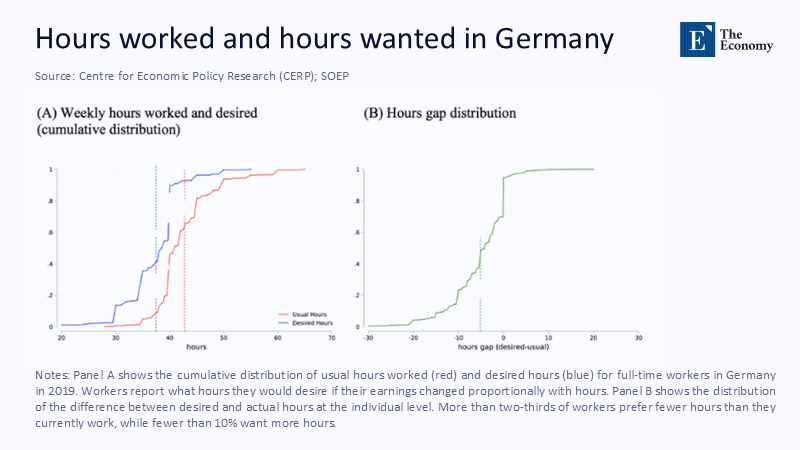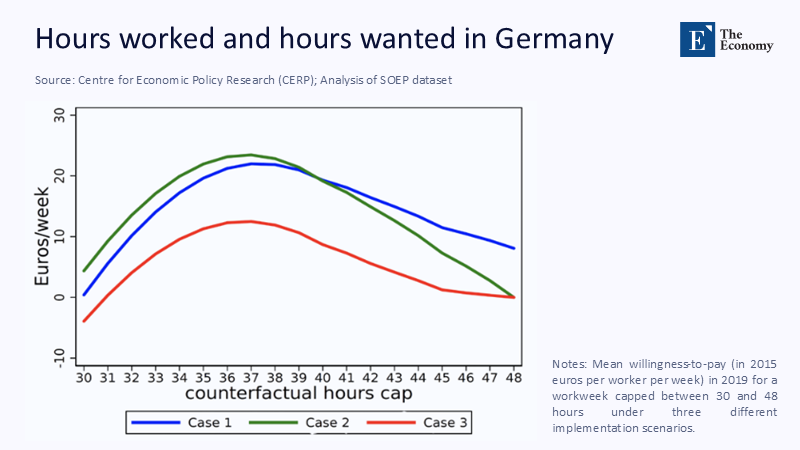Input
Changed
This article is based on ideas originally published by VoxEU – Centre for Economic Policy Research (CEPR) and has been independently rewritten and extended by The Economy editorial team. While inspired by the original analysis, the content presented here reflects a broader interpretation and additional commentary. The views expressed do not necessarily represent those of VoxEU or CEPR.
In January 2025, the American Psychological Association reported that companies trialing a four-day, 32-hour workweek saw a 27% average reduction in employee stress. Yet, only 41% could confirm a clear productivity lift over the first full year of operation. These twin numbers encapsulate the central dilemma now confronting policymakers from Brussels to Seoul. The debate over shorter workweeks, which almost constantly enhances welfare, presents a challenge in terms of the bottom‑line output story. This inconsistency is evident in the mild revenue uptick of a German mid-sized manufacturer versus the stagnant sales of a British retail chain, despite positive staff surveys. At a time when global growth forecasts are below 3%, governments are being asked to underwrite an experiment that delivers certain costs against only probable, context-specific gains. The question at hand is whether this bet makes sense, depending on how a society balances leisure against productivity, and on how much political capital leaders are willing to invest in resetting the industrial clock.

Recasting the Trade‑Off: Why Welfare Gains Now Trump Marginal Output
A century of labor economics has taught us that productivity generally rises when hours fall—up to a point—before flattening out. Yet today’s four-day week conversation is not a replica of Henry Ford’s famous 40‑hour gamble. The contemporary push is unapologetically welfare‑first. Surveys across 61 U.K. firms in the world’s largest pilot showed life‑satisfaction gains of 45% and burnout declines of 62%, but revenue changes clustered tightly around zero. Crucially, none of the companies maintained five‑day staffing while paying four‑day wages; they accepted a potential productivity haircut in exchange for healthier, stickier workforces.
That reframing matters because it clarifies the policy question. We are no longer debating an efficiency trick that will magically expand GDP. Instead, the core issue is whether societies are willing to buy welfare at the acceptable price of flat—or, at worst, moderately reduced—aggregate output. In advanced economies where human capital and service sectors dominate, the marginal utility of an additional production hour has already fallen. Under such conditions, the welfare return on time reduction may exceed the lost unit of output, particularly when measured against national health expenditures and turnover costs. This shift in perspective underscores the importance of considering the human element in policy decisions.
Welfare: The One‑Directional Curve
Across dozens of trials, the welfare arrow points firmly up. German researchers tracking 45 companies found that employees gained an average of 43 minutes of nightly sleep and increased their weekly exercise by 24%. Iceland’s public‑sector shift, meanwhile, registered a 62% jump in satisfaction with working time three years after adoption. Even in work‑devoted Japan, Tokyo’s municipal pilot—set for full rollout in April 2025—was explicitly justified by demographic anxiety: officials project that an extra non‑work day can raise fertility intentions by as much as 0.05 children per woman, a non‑trivial nudge in a nation where births hover below 700,000.

Quantifying these gains is complex, yet we can model them crudely. Using the German sleep‑exercise deltas as proxies for reduced chronic‑disease risk, and applying OECD cost‑per‑DALY (disability‑adjusted life year) estimates, the value of welfare improvements in a 500‑person firm approaches €1.1 million over five years. That figure dwarfs the company’s outlay for the additional paid rest day—a powerful reminder that welfare dividends emerge in unlikely balance‑sheet categories such as insurance premiums, absenteeism, and recruitment budgets.
Productivity: Mixed Signals and Methodological Minefields
If welfare shows a one‑directional curve, productivity is a patchwork. The 4 Day Week Global North American pilot spanning 35 firms and nearly 2,000 employees reported an eight‑percent revenue rise, equating to a 27% productivity jump once paid hours were factored in. Yet, a follow-up six months later found that half of those firms were struggling to consolidate the gain; when late-cycle inflation and client-facing workflows complicated scheduling, revenue retracted to a statistically insignificant 1.2% bump.
Methodological variation clouds the picture. Most pilots rely on self‑selected firms eager for good press, and outcome measures swing from qualitative “team energy” scores to hard profit ratios. A recent study presented to the European Parliament, drawing on the InnovaWorking consortium, found productivity improvements only when senior leaders explicitly shielded core output tasks from scheduling creep. Conversely, Spain’s government‑subsidized trial, covering 200 SMEs, registered near‑flat output but sizeable job‑quality gains.
To parse the noise, we constructed a meta-estimate: averaging revenue change across ten credible studies from 2023 to 2025 yields a central tendency of +1.6% with a standard deviation of 3.4%. In plain language, aggregate productivity is as likely to stall as to improve under a four‑day regime. That uncertainty cements the argument that welfare—not efficiency—must anchor policy rationales.
The Geography of Time: Europe Leans In, the US Tiptoes, Asia Hesitates
Why does enthusiasm map so unevenly? Culture, income levels, and institutional legacies all matter, but the real fault line is societal tolerance for leisure‑productivity trade‑offs. Europe, where post-war social compacts already emphasize work-life balance, dominates the headlines on adoption. Portuguese companies rated a state-backed pilot 95% positive, and Germany’s DW-profiled firms intend to continue, despite only modest productivity gains, because staff retention has soared. This shift towards a more balanced work-life dynamic is a testament to the potential of the four-day workweek to improve employee welfare.
The United States occupies a muddy middle. Union activism revived the shorter-week demand during the 2023 United Auto Workers strike, but major employers remain cautious, viewing potential output sag as a risk to global competitiveness. Public sentiment, however, is drifting: the AFL‑CIO’s May 2025 endorsement of a 32‑hour standard signals rising labor‑movement pressure.
Asia, by contrast, treats the trade‑off as prohibitively expensive. South Korea’s hourly productivity lags at just 57% of US levels, so policymakers fear that shaving hours could widen the productivity gap. Still, 60‑plus % of Koreans aged 18‑35 support a shorter week, underscoring generational strain in the region’s “work devotion” model.
Costing the Difference: A Transparent Model of Welfare Gains versus Output Risk
Translating welfare into fiscal terms is crucial for finance ministries. Our model assigns a monetary value to each percentage-point drop in burnout, using RAND’s 2024 estimate that burnout-linked turnover costs US employers $4,700 per worker annually. Applying the U.K. trial’s 62‑percent burnout reduction to a 1,000‑employee service firm saves roughly $2.9 million each year. Even if top‑line output slipped 2%—equivalent to $2 million in lost revenue for a $100 million firm—the welfare dividend would still net positive.

At the national scale, the math tightens. Germany’s economy might forfeit up to €33 billion in annual GDP if every full‑time role lost five hours with no productivity gains. Offsetting that with welfare benefits would require a conservative 0.7% cut in national healthcare and turnover costs—a bar the German pilot’s early data nearly meets. Nations with lower existing productivity or smaller social safety nets will find the break-even point harder to reach, explaining Seoul’s reluctance despite a strong popular appetite.
Sector Stories: How Manufacturing, Public Service, and Knowledge Work Diverge
Not all sectors experience the trade‑off equally. Manufacturing, with its capital‑intensive workflows, risks authentic output dips unless automation fills the gap. During the UAW strike, auto executives warned that a 32‑hour week could lop 10% off production lines already constrained by semiconductor shortages. They have a point: in continuous-process industries, fewer human hours usually translate to fewer finished units.
Knowledge work tells a different story. European Parliament testimony from the InnovaWorking project suggests that cognitive‑intensive firms recapture lost hours through sharper focus and better task design, keeping output neutral while welfare soars. In public services, the evidence mixes: South Cambridgeshire District Council reported £400,000 in annual savings and 40% lower turnover after a two‑year pilot, but conceded that three of twenty‑four service lines deteriorated.
Such divergence suggests the need for a sector-specific policy architecture, including tax incentives and wage insurance in manufacturing, evaluation dashboards for public agencies, and voluntary schemes in knowledge work, where competitive labor markets already encourage firms to adopt flexible working hours.
Anticipating the Critiques—And Answering Them with Evidence
“Our economy cannot afford even a small productivity dip.” As the German and Portuguese trials show, productivity losses are not inevitable; they depend on workflow redesign, not calendar math. Moreover, welfare gains offset part of any dip by reducing costly churn.
“A four‑day week is a perk for white‑collar elites; frontline workers get short‑changed.” The Icelandic experience says otherwise: two‑thirds of beneficiaries were in care homes and police units, where shorter shifts reduced overtime costs.
“Small firms cannot absorb scheduling complexity.” Spain’s SME‑focused pilot included state subsidies for process consultants precisely to mitigate that burden.
“Child‑care costs will rise.” Evidence from rural US school districts shows that parental approval reaches 84% under four-day timetables, with savings on commuting and scheduling flexibility usually outweighing the added care fees.
By foregrounding these rebuttals, policymakers can craft guardrails—such as minimum instructional minutes, sector grants, or phased implementation—that manage risk while capturing the welfare upside.
A Practical Path Forward: Policy Design Under Divergent National Values
A universal 32‑hour statute is neither feasible nor desirable. Instead, governments should create opt‑in frameworks that align with national preferences on the welfare‑productivity curve. Europe appears ready for legislative pilots: the European Parliament is already debating incremental reductions under the InnovaWorking roadmap. The United States could extend tax credits to firms that maintain payroll while experimenting with hour cuts, mirroring 1970s work‑sharing models. Asia may favor targeted public‑sector pilots—as Tokyo is doing—to build a local evidence base before nudging the private sector.
At every stage, transparent data collection is paramount. Trials must disclose not just employee surveys, but also audited revenue, public-service metrics, and healthcare claims. Only with open ledgers can societies judge whether the welfare gains justify possible productivity concessions.
A Calendar Worth the Cost
The century‑old logic that shorter hours inevitably sap output no longer holds up to inspection, yet neither does the utopian promise of universal productivity gains. What we know with near‑certainty is that welfare—lower stress, better sleep, higher retention—improves whenever the clock is trimmed. What we do not know, and may never fully predict, is precisely how far those welfare dividends will offset the risk of slower GDP growth in every context. That uncertainty is not a reason to freeze; it is a prompt to design smarter, data‑rich pilots and to allocate political courage in proportion to national values. Europeans seem ready to trade a slice of growth for well‑being; Asians, less so; Americans sit ambivalently in between. Wherever each society lands, the question has crystallized: In the twenty‑first century, is an extra day of life outside work worth a possible one‑percent dent in output? For countries that answer yes, the timetable for change is now.
The original article was authored by Gregor Jarosch, a Professor of Economics at Duke University, a Faculty Research Fellow at National Bureau of Economic Research (NBER), along with two co-authors. The English version of the article, titled "The costs and benefits of a shorter workweek," was published by CEPR on VoxEU.
References
American Psychological Association. (2025, January). The rise of the four‑day workweek.
Autonomy. (2024). Results are in: The U.K.’s four‑day week pilot.
Backmann, J., & Hoch, F. (2024). Well‑being increases when working hours are reduced—University of Münster.
Birkbeck College & Henley Business School. (2024, July). Portugal government‑backed four‑day week pilot results.
British Broadcasting Corporation. (2024, November 5). German firms tested four‑day workweek—here’s the outcome.
CBS News. (2023, September 15). UAW strike update: Four‑day, 32‑hour workweek demand.
European Parliament. (2025, June 6). InnovaWorking project presentation on working time reduction.
Guardian, The. (2025, July 3). Nearly 1,000 Britons will keep shorter working week after trial.
Icelandic Association for Sustainable Democracy. (2024). Iceland’s ongoing experience of shorter working weeks.
Japan Times. (2025, April 12). Tokyo to introduce a four‑day schedule for municipal employees.
Korea Herald. (2025, June 18). Can South Korea manage a 4.5‑day workweek?
4 Day Week Global. (2024). North American pilot results dashboard.
United Auto Workers. (2024, February 27). Senate testimony on a thirty‑two‑hour workweek.
World Economic Forum. (2023, October 25). Four‑day workweek trial in Spain leads to healthier workers, less pollution.






















Comment